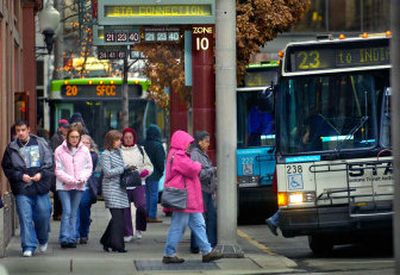STA decides bigger is better

The Spokane Transit Authority is delaying plans to purchase smaller buses.
Officials said Thursday that several routes have increased ridership requiring larger buses, and an earlier plan to downsize buses would have left them with too many small vehicles if voters don’t reauthorize a sales tax for transit operations in 2008.
Such a scenario would eliminate the lower ridership routes that use smaller buses and would mean more riders crowded onto fewer routes, necessitating larger buses.
STA still plans to purchase the same mix of small and large buses but is simply pushing the small-bus purchases to a later date, said board member and Spokane Valley City Councilman Dick Denenny.
“The total numbers aren’t changing,” said Denenny, who added that he was initially concerned about the change in plans because his constituents have made it clear they don’t like seeing empty, large buses.
Smaller buses were one of the promises that STA officials made to the public after voters approved a .3 percent sales tax increase (3 cents on a $10 purchase) in 2004.
But Denenny said he is satisfied that smaller buses will still be purchased in the future and believes there are valid reasons to buy larger buses now.
Several routes, including the new City Loop route and Medical Lake route have seen higher numbers of riders since service changes last fall. They now need larger buses than originally anticipated, said Operations Director Steve Blaska.
And then there is the issue of funding.
The sales tax increase sunsets if not reauthorized in 2008.
The new bus purchase plan moves bigger buses to the front of the line, suspends bus buys in 2008 and restarts with smaller buses only if the tax is reauthorized in fall 2008.
Buying larger buses first also saves STA money upfront.
Because the federal government offers grants to purchase 40-foot buses but not 35-foot buses, STA will save almost $450,000 this year by buying the larger buses instead of the small ones.
STA also operates a few 60-foot buses on some of its most traveled routes, like the East Sprague route between downtown Spokane and Spokane Valley.
Smaller buses do cost a little less to operate than their larger counterparts, but only 17 percent of operating costs can be controlled by size. Other factors – like drivers’ wages and maintenance costs – are the same regardless of bus size, Blaska said.
“It’s not worth the risk of having the wrong buses in 2009,” said Blaska of the potential operating cost savings. “We want to make sure we can use all the new buses, even in a reduced-service scenario.”